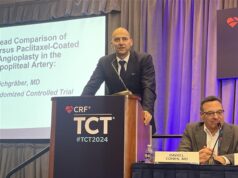
Delivering first-release data, Scott O Trerotola (University of Pennsylvania, Philadelphia, USA) conveyed the “consistent results” in a real-world environment for the Lutonix arteriovenous (AV) post-approval study (PAS) for drug-coated balloon (DCB)-AV on the afternoon of the second day at this year’s Leipzig Interventional Course (LINC 2023; 6–9 June, Leipzig, Germany).
The study objective was to demonstrate safety and assess the clinical use of the Lutonix DCB for treatment of dysfunctional AV fistulae located in the arm as part of a post approval study mandated by the US Food and Drug Administration (FDA). In order to be enrolled, Trerotola defined that there needed to be successful predilation—meaning no significant dissection or extravasation, residual stenosis less than 30%, and complete effacement of the waist on the initial pretreatment angioplasty high-pressure balloon, after which point the DCB is used.
Trerotola highlighted that they intend on enrolling 213 patients but are, at present, halfway enrolled, noting his presentation currently regards the 81 patients for which the interim analysis was performed. Expanding on the demographics of their patient population, the speaker additionally noted that 64.2% of patients are male and enrolled participants currently have a mean age 64.6.
Presenting their data to the LINC 2023 audience, Trerotola emphasised that “importantly—not to anyone’s surprise at this point—the safety and lack of events is 100%, so the device is safe and this is something that has come out of all of the trials.” He noted specifically to the six month target lesion primary patency (TTLP) for the Lutonix device was 77.6%, this endpoint defined as the time to clinically driven reintervention or thrombosis.
Comparing their results to the Lutonix global registry trial and the IN.PACT investigational device exemption (IDE) trial, which received 73.9% and 82.2% six month primary patency for the Lutonix DCB and IN.PACT DCB respectively, Trerotola highlighted the “extremely reassuring and heartening” outcome they have achieved, delivering “as good or better” results in their post-approval study.
Comparing these data to those from other studies, Trerotola stated that there are prevalent “demographic differences” between the Lutonix IDE and PAS studies when compared to the IN.PACT IDE trial and Lutonix Global registry, as the Lutonix studies enrolled only North American patients resulting in far fewer forearm fistulae. Furthermore, dosage differs between the devices which Trerotola noted to the audience.
Finally concerning the execution of DCB research, Trerotola made clear mention of the requirement to “do everything right to get the best results”. “We learned the lesson the hard way in our post-approval study when we initially told investigators they needed to inflate for 30 seconds. We later had to increase this to two minutes due to emerging data, and in the IN.PACT study they were all over three minutes—those variables are important.”
In summary of their first-release study data, Trerotola stated that the Lutonix is the first US Food and Drug Administration (FDA) post-approval study in the AV setting, and that it “very reassuringly shows us very good results at six months and a good safety record.
“We will now eventually add an additional 213 subjects to an emerging level of evidence of over 800 subjects studied prospectively to date with the Lutonix device, and I think it is very important when moving forward to pay attention to the heterogeneity in the DCB studies and to try and figure out how to personalise DCB used in the future.” Trerotola concluded his presentation by reiterating that, most importantly, “if we are going to use these devices, we have to use them correctly and we have to get the vessel ready correctly before we do so”.













